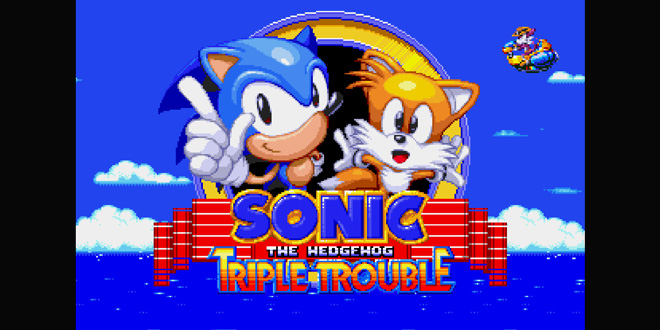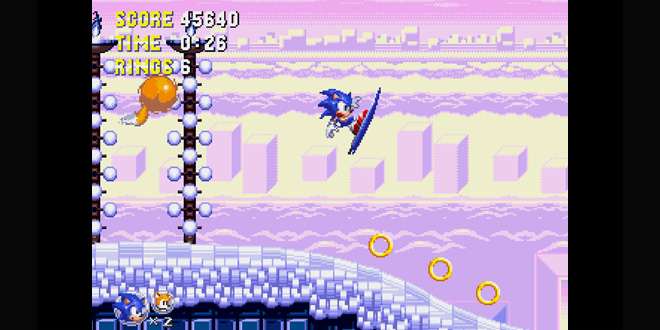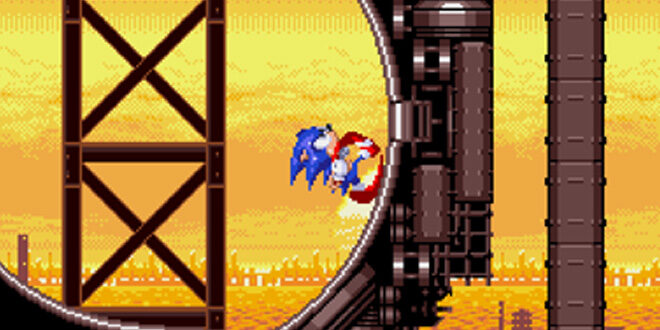Sonic the Hedgehog fandom is very much regarded as one of the most creative and passionate communities in the video games space. It often compared to the likes of Doom’s in regards to its dedication to creating new experiences based upon beloved games that have rightly attained immortality.
Given the go-ahead by SEGA as long as they don’t make any profit, and unable to get enough of the blue blur that defined a generation of consoles (and caused many an argument on the playground about which console was better – it was the Mega Drive, if you were wondering), Sonic fans have often taken things into their own hands. During the droughts between new 2D entries in the series that seem to only be getting longer as Sonic races further away from his inception, fans have dutifully kept the franchise watered.

BACK IN TIME
 One such person is Noah Copeland, an indie developer from Texas who works as a film composer by day, and has been working on remaking Sonic Triple Trouble (known in Japan as Sonic & Tails 2) with his free time for the last five years. Triple Trouble is a game exclusive to the under-appreciated SEGA Game Gear, and is likely also a video game all but the most ardent fans have probably forgotten. So why did Copeland decide to create Sonic Triple Trouble 16-Bit? Why are you, dear reader, not learning all about another game like Sonic Chaos 16-Bit, or even something else entirely? It all comes down to a chance encounter on a film set.
One such person is Noah Copeland, an indie developer from Texas who works as a film composer by day, and has been working on remaking Sonic Triple Trouble (known in Japan as Sonic & Tails 2) with his free time for the last five years. Triple Trouble is a game exclusive to the under-appreciated SEGA Game Gear, and is likely also a video game all but the most ardent fans have probably forgotten. So why did Copeland decide to create Sonic Triple Trouble 16-Bit? Why are you, dear reader, not learning all about another game like Sonic Chaos 16-Bit, or even something else entirely? It all comes down to a chance encounter on a film set.
“I was working on a film and we had wrapped for the day, when someone in the crew brought out the Sonic Gems Collection. We found ourselves playing the Game Gear titles like Sonic Chaos and Sonic Triple Trouble. I had always wanted to make my own Sonic game, so these two titles stood out to me as something begging for a remake.” explains Copeland. “I went back and forth between the two before deciding that Triple Trouble’s level design would translate better to the 16-Bit style. This ended up being a moot point, as I ended up redoing all of the level design anyway. I had naively thought I could just do a “better graphics only” kind of remake and have it done in a year … I was very wrong!”
DON’T MAKE THE SUN LAUGH AT YOU
After quickly realising that just upgrading the graphics wouldn’t be enough if he really wanted to bring Sonic Triple Trouble forward a generation, Copeland knew he would have to do his homework, and when it came to influences on his project, there was one clear winner.
“In my mind, this game is a hypothetical Mega Drive game from 1995 that never actually existed. This means it would need to be a sequel to Sonic 3 & Knuckles. I looked at every Sonic game. Classic games, modern games, 3D games, fan games, but Sonic 3 & Knuckles is the one I kept coming back to.” says Copeland. “It’s the first game I ever bought, so it holds a special place in my heart. The level design is such a perfect balance of speed and platforming. I probably spent most of the five years struggling to nail that signature Sonic balance of speed and platforming in my own game.”
One of the key differences between the Master System and Game Gear Sonic games and their counterparts on Mega Drive is that Hirokazu Yasuhara was the man in charge of the level design on the latter. Yasuhara is responsible for a lot of what gamers remember about the Hedgehog’s early adventures, despite often being overshadowed by programmer Yuji Naka and character designer Naoto Oshima, who are often considered to be the character’s creators. Any follow up to Sonic 3 & Knuckles would absolutely have to contain that Yasuhara factor, and Copeland thankfully understands that.
“Yasuhara has spoken publicly about his main design pillars: chance, competition, imitation, and vertigo. These were derived from French intellectual Roger Caillois’s book Man, Play, and Games. However, I think there’s an unspoken pillar that is very present in his work, and that’s novelty. I define “novelty” in this case as a constant influx of new ideas. By comparison, Mario levels are about exploring a singular idea. They take one concept and develop it in a very logical manner throughout the level in a very linear fashion.” he explains.
“Sonic levels, on the other hand, are large, intersecting ant hills that are constantly throwing new ideas at you to achieve a sense of novelty. Sonic levels don’t care if an idea goes undeveloped; they are more than happy to use an idea once and throw it away, as long as it’s fun. Sonic levels, much like Sonic himself, never want to be boring or stay in the same place too long. If you look at the natural progression of Sonic levels over time, they also have an increasing sense of spectacle. I really wanted to nail that with my more bombastic levels like the train ride in Sunset Park, or the exploding blimp in Egg Zeppelin. You are often moving from one set-piece to the next, which also helps create that sense of novelty.”

THE REAL SUPER POWER OF TEAMWORK
Copeland is also keen to point out that despite the fact he did a substantial amount of work on his recently released Sonic fangame, other creative types had pitched in to help too by the time it was released. Once he was no longer a one man band, this meant a lot more structured planning would be required, turning him into a fully fledged game director, and probably also making the process of game development a lot more straightforward too.
“I had quite a bit of help with pixel art during the last year of development. I definitely learned a lot. As a game developer, you love to just jump into your software and start tinkering and coding with stuff. However, I found that if you spend the first 30 minutes of the day planning and preparing, it can supercharge your productivity. Open up a notepad and start writing out your dev goals for that day.” explains Copeland. “The more you define the ‘what’, the better. What tools will you need? What’s the best way to code or implement them? Casting a vision like this is quite effective. It helps you get better at articulating whatever you are trying to accomplish. When it comes time to work with collaborators, articulating that vision back to them helps get everyone on the same page. As a director, your value lies in your vision and how defined it is. As a designer, your value is executing that vision.”
It turns out that executing his vision was one of the things that posed a challenge for the game during its development however. Issues popped up in the quest for accuracy, with Copeland not wanting to settle for something akin to the NES+ style of Yacht Club Games’ Shovel Knight and other indie contemporaries. If he was going to simulate the 90s Sega aesthetic, he was going to go all the way.
“Because I wanted this to feel like a Mega Drive game, I was constantly self-imposing limitations on the art and graphical effects. If it wasn’t possible on Mega Drive, we didn’t do it. There are never more than 64 colours on screen at one time, because that’s how it would’ve been in the 1990s! I did a lot of research by playing and listening to a lot of old Sega games. Not just Sonic. It had to feel real. For the music and effects, we also used a tool called F-M Drive that emulates the sound of the Mega Drive’s Yamaha sound chip. It was important to get that twangy sound.”
LIVE AND LEARN
So would Copeland suggest people make a fan game to learn the ins-and-outs of video game design? He definitely still seems enthusiastic about fan games and their capacity as a learning tool, but also believes that any would-be developers that take on such a challenge should know when to stop iterating and move on.
“It is definitely a great learning experience! The learning advantage of a fan game is the fact that you have a finished product to reference before you even start. You have a predefined target to aim at. If you are developing an original game, you spend so much time struggling to find out if your initial idea will even be fun. But by making a Sonic fan game, I don’t find myself questioning if the game is inherently flawed. I already know that Sonic is fun! I’ve played real Sonic games, and they are a blast.” he says, still obviously a fan.
“So if my game is not fun, it’s not a fundamental design issue, it’s a me-issue. Then I’ve got to figure out what I’m doing wrong to get back to that gold standard of those wonderful 16-bit Sonic games. It’s very educational. Just understand that creating and finishing are two different skill sets. Creating is an art that never ends. Finishing is the art of deciding when it ends. Too many creatives never develop the latter skill set. Keep your team small. Keep your scope small. Get it finished. You’ll learn more from finishing something in five years than from creating something endlessly over ten years or more.”

DREAMS COME TRUE
As for Sonic the Hedgehog Triple Trouble 16-Bit and its audience reaction? Well, the fans love it, as the passion project rightfully deserves to be loved, and Copeland is pleased with how everything turned out in the end. “As a developer, you should always prepare for the fact that strangers on the internet are going to be very mean to your game, but I can’t believe what a small percentage the naysayers make up. The majority of comments I get are heart-warmingly positive. I’ve had people tell me it’s their favourite game, or tell me it made them smile so much they shed a tear. I’ve even had people tell me they play it with their son as a bonding thing.”
“Since the moment the game came out, my social media has not stopped ringing. It’s just message after message, comment after comment, and it’s so positive.” says Copeland. “After five years of not knowing if anyone would really play it, I cannot begin to tell how satisfying it is to see so many people having fun. That’s what video games are for after all. Like Reggie Fils-Aimé once said, “It’s not fun, what’s the point?” If you are making something, believe in it and finish it. Make a splash on your tiny corner of the world. You can do it!”

 MCV/DEVELOP News, events, research and jobs from the games industry
MCV/DEVELOP News, events, research and jobs from the games industry




